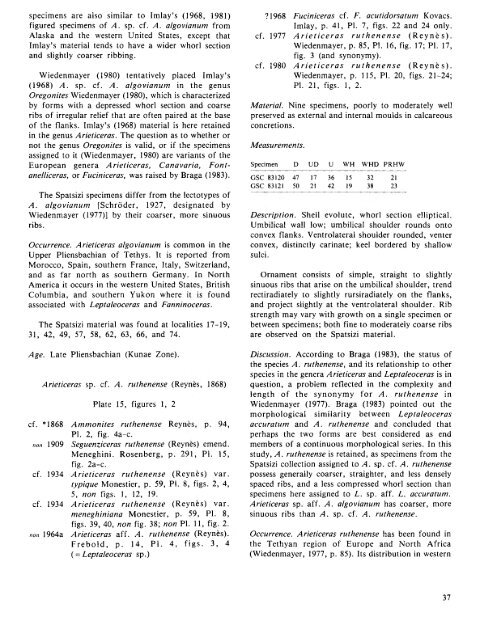PLIENSBACHIAN (LOWER JURASSIC) BIOSTRATIGRAPHY AND ...
PLIENSBACHIAN (LOWER JURASSIC) BIOSTRATIGRAPHY AND ...
PLIENSBACHIAN (LOWER JURASSIC) BIOSTRATIGRAPHY AND ...
Create successful ePaper yourself
Turn your PDF publications into a flip-book with our unique Google optimized e-Paper software.
specimens are also similar to Imlay’s (1968, 1981)<br />
figured specimens of A . sp. cf. A . algovianum from<br />
Alaska and the western United States, except that<br />
Imlay’s material tends to have a wider whorl section<br />
and slightly coarser ribbing.<br />
Wiedenmayer (1980) tentatively placed Imlay’s<br />
(1968) A . sp. cf. A . algovianum in the genus<br />
Oregonites Wiedenmayer (1980), which is characterized<br />
by forms with a depressed whorl section and coarse<br />
ribs of irregular relief that are often paired at the base<br />
of the flanks. Imlay’s (1968) material is here retained<br />
in the genus Arieticeras. The question as to whether or<br />
not the genus Oregonites is valid, or if the specimens<br />
assigned to it (Wiedenmayer, 1980) are variants of the<br />
European genera A rieticera s, C anavaria, F o n t-<br />
anelliceras, or Fuciniceras, was raised by Braga (1983).<br />
The Spatsizi specimens differ from the lectotypes of<br />
A . algovianum [Schroder, 1927, designated by<br />
Wiedenmayer (1977)] by their coarser, more sinuous<br />
ribs.<br />
Occurrence. Arieticeras algovianum is common in the<br />
Upper Pliensbachian of Tethys. It is reported from<br />
Morocco, Spain, southern France, Italy, Switzerland,<br />
and as far north as southern Germany. In North<br />
America it occurs in the western United States, British<br />
Columbia, and southern Yukon where it is found<br />
associated with Leptaleoceras and Fanninoceras.<br />
The Spatsizi material was found at localities 17-19,<br />
31, 42, 49, 57, 58, 62, 63, 66, and 74.<br />
Age. Late Pliensbachian (Kunae Zone).<br />
Arieticeras sp. cf. A . ruthenense (Reynes, 1868)<br />
Plate 15, figures 1, 2<br />
cf. *1868 A m m o n ites ruthenense Reynes, p. 94,<br />
PI. 2, fig. 4a-c.<br />
non 1909 Seguenziceras ruthenense (Reynes) emend.<br />
Meneghini. Rosenberg, p. 291, PI. 15,<br />
fig. 2a-c.<br />
cf. 1934 A rie tic e ra s ru th e n e n se (Reynes) var.<br />
typique Monestier, p. 59, PI. 8, figs. 2, 4,<br />
5, non figs. 1, 12, 19.<br />
cf. 1934 A rie tic e ra s ru th e n e n se (Reynes) var.<br />
m eneghiniana Monestier, p. 59, PI. 8,<br />
figs. 39, 40, non fig. 38; non PI. 11, fig. 2.<br />
non 1964a A rieticeras aff. A . ruthenense (Reynes).<br />
F re b o ld , p. 14, PI. 4, figs. 3, 4<br />
(= Leptaleoceras sp.)<br />
71968 Fuciniceras cf. F. acutidorsatum Kovacs.<br />
Imlay, p. 41, PI. 7, figs. 22 and 24 only,<br />
cf. 1977 A r i e t i c e r a s r u t h e n e n s e (R e y n e s ).<br />
Wiedenmayer, p. 85, PI. 16, fig. 17; PI. 17,<br />
fig. 3 (and synonymy),<br />
cf. 1980 A r i e t i c e r a s r u t h e n e n s e (R e y n e s ).<br />
Wiedenmayer, p. 115, PI. 20, figs. 21-24;<br />
PI. 21, figs. 1, 2.<br />
Material. Nine specimens, poorly to moderately well<br />
preserved as external and internal moulds in calcareous<br />
concretions.<br />
M easurements.<br />
Specimen D UD U W H W H D PR H W<br />
GSC 83120 47 17 36 15 32 21<br />
GSC 83121 50 2! 42 19 38 23<br />
D escription. Shell evolute, whorl section elliptical.<br />
Umbilical wall low; umbilical shoulder rounds onto<br />
convex flanks. Ventrolateral shoulder rounded, venter<br />
convex, distinctly carinate; keel bordered by shallow<br />
sulci.<br />
Ornament consists of simple, straight to slightly<br />
sinuous ribs that arise on the umbilical shoulder, trend<br />
rectiradiately to slightly rursiradiately on the flanks,<br />
and project slightly at the ventrolateral shoulder. Rib<br />
strength may vary with growth on a single specimen or<br />
between specimens; both fine to moderately coarse ribs<br />
are observed on the Spatsizi material.<br />
Discussion. According to Braga (1983), the status of<br />
the species A . ruthenense, and its relationship to other<br />
species in the genera Arieticeras and Leptaleoceras is in<br />
question, a problem reflected in the complexity and<br />
length of the synonymy for A . ru th e n e n se in<br />
Wiedenmayer (1977). Braga (1983) pointed out the<br />
morphological similarity between L eptaleoceras<br />
accuratum and A . ruthenense and concluded that<br />
perhaps the two forms are best considered as end<br />
members of a continuous morphological series. In this<br />
study, A . ruthenense is retained, as specimens from the<br />
Spatsizi collection assigned to A . sp. cf. A . ruthenense<br />
possess generally coarser, straighter, and less densely<br />
spaced ribs, and a less compressed whorl section than<br />
specimens here assigned to L . sp. aff. L. accuratum.<br />
Arieticeras sp. aff. A . algovianum has coarser, more<br />
sinuous ribs than A . sp. cf. A . ruthenense.<br />
Occurrence. Arieticeras ruthenense has been found in<br />
the Tethyan region of Europe and North Africa<br />
(Wiedenmayer, 1977, p. 85). Its distribution in western

















